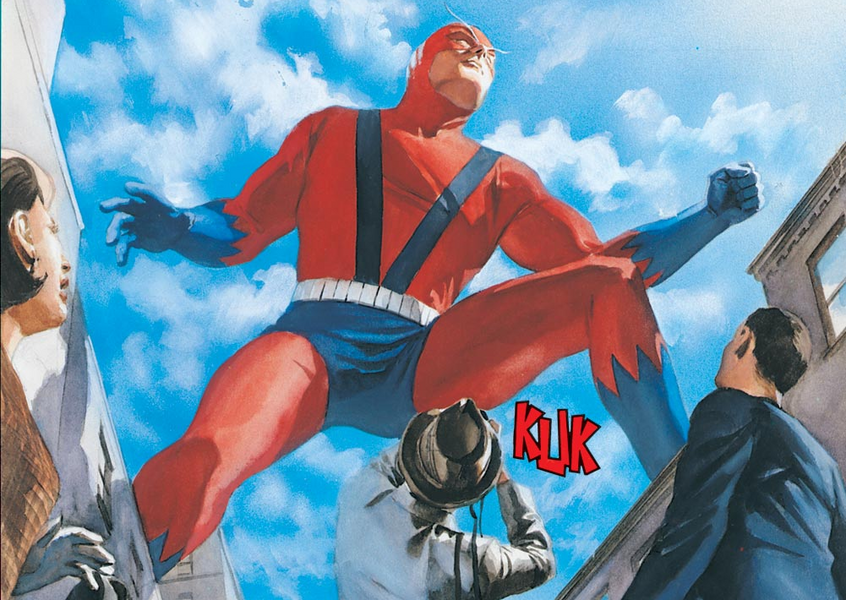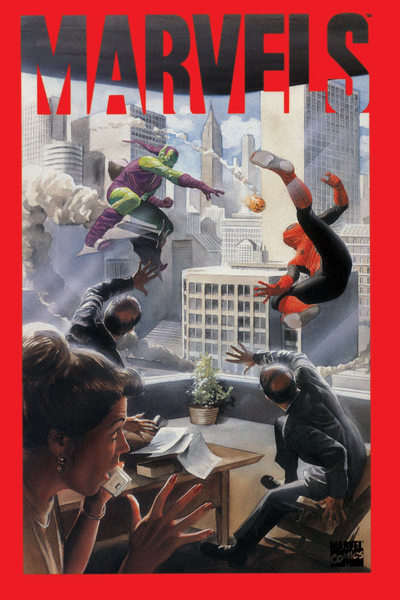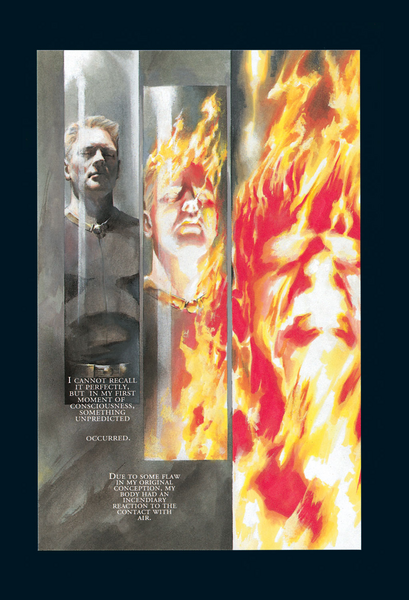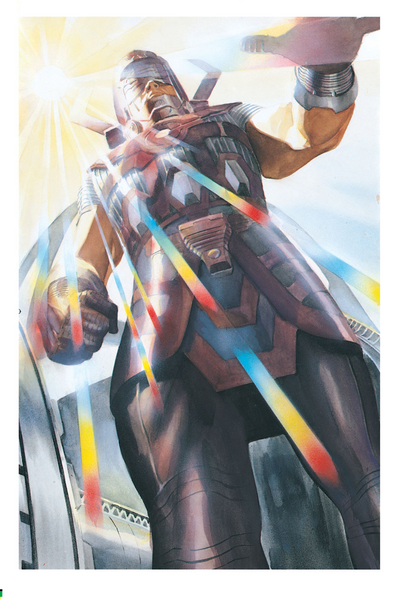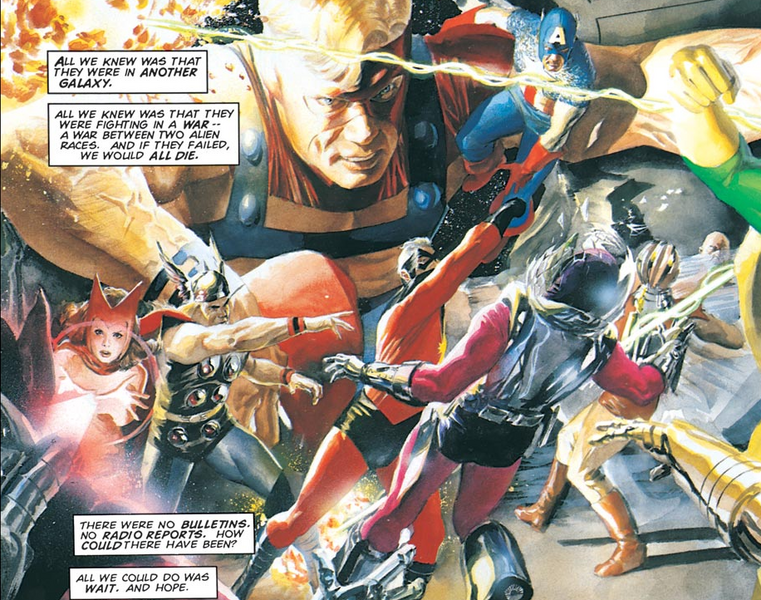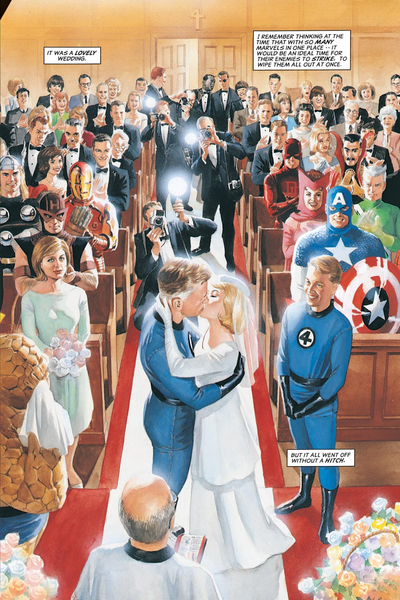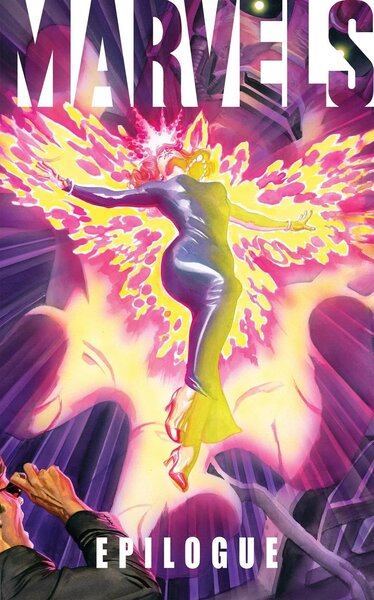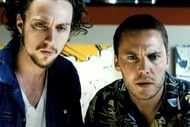Create a free profile to get unlimited access to exclusive videos, sweepstakes, and more!
How Marvels broke the superhero comics mold 25 years ago and what's next in the Epilogue
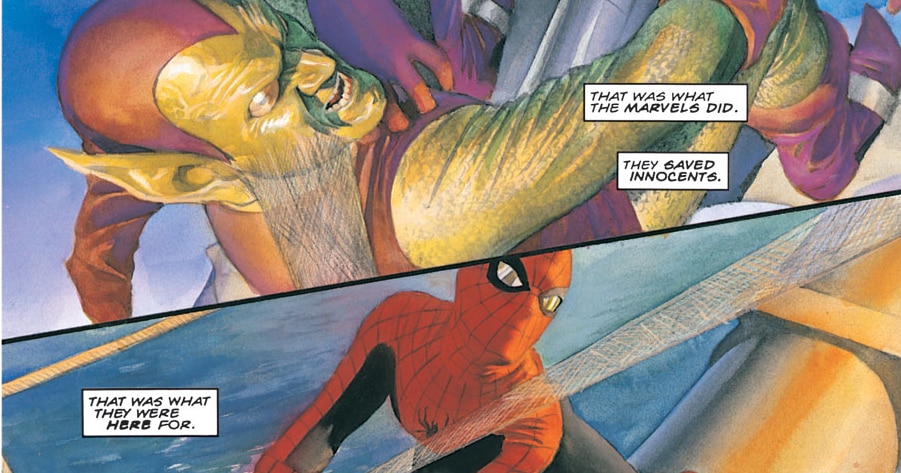
When Stan Lee and Jack Kirby launched Marvel Comics into the stratosphere with characters like the Fantastic Four, Spider-Man and the Hulk in the early 1960s, fans were drawn to the fact that these new superheroes were written as real folks, with real problems, living in the real world. When Marvels debuted in 1994, combining the ultra-realistic art of Alex Ross and storytelling skills of Kurt Busiek, fans were struck with that same feeling of what it must have been like living among superpowered humans, monsters, and villains, all larger than life.
Marvels follows the path of young New York photographer Phil Sheldon, who bears witness to the birth of superheroes with the Human Torch and follows their rise through the 1960s. In each of the five issues (somewhat confusingly numbered #0 to 4), Busiek and Ross touch upon the many different corners of the burgeoning Marvel Universe. Plus, there are dozens of references to actual events in the Marvel Universe, from running into the Fantastic Four on Reed and Sue's wedding day (seen in Fantastic Four Annual #3) to documenting the rise of the X-Men and even the arrival of Galactus (seen in Fantastic Four #48). Phil Sheldon is a key witness to some of the biggest moments in Marvel history.
25 years and several awards later, Marvels is still a fan favorite and even spawned several spinoffs, including the frightening Ruins and Marvels: Eye of the Camera, released in 1995 and 2008, respectively. Coming up next month, Marvel is set to release Busiek and Ross' latest installment, Marvels: Epilogue. Set for a July 24 release, the 16-page story serves as an all-new epilogue to the original Marvels, done by the original team.
Busiek spoke to SYFY WIRE about the creative process that went into creating Marvels, how they chose what comic book history to highlight and what fans can expect from Marvels: Epilogue and beyond.
About two decades before Alex Ross was a regular cover artist for Marvel Comics, he was still an up-and-coming artist living in Chicago. By 1993, Ross was still in the process of breaking into the comic book business. Ross had teamed up with Ron Fortier on a Terminator adaptation in 1990, done some work with Miracleman in 1992 and worked on a few issues of the Marvel Comics adaptation of Hellraiser that same year.
In 1993, things changed for Ross. He was given his first superhero job, designing a cover for Superman: Doomsday & Beyond for DC Comics, and that inspired a new idea. Ross' original plan for Marvels was actually an ongoing anthology called Marvel, where various artists — including him, of course — could do painted stories of the Marvel superheroes.
"He had a selection of character he was most interested in painting, from Namor and the original Human Torch to the Thing, Gwen Stacy, the Black Panther and more," recalls Busiek, who had met Ross a few years prior when Busiek was on staff at Marvel. "I was editing a series called Open Space, and hired him to do a story. I'd since left Marvel and was working as a freelance writer, but he figured I still knew more people than he did. So he sent me his samples for the project, and as I said, I was advising him on it."
At the time, Busiek says, he didn't think of himself as a potential writer for it — as far as he knew, Alex was working with someone he knew in Chicago.
"I'd been making suggestions — telling him that Marvel wasn't going to buy a new anthology from an unknown artist, particularly not one that the artist was only proposing to do some," Busiek says. "I thought he needed a story, something with a beginning, middle and end, and a character whose story would run through the thing, tie it all together. We talked about a lot of dumb ideas, but by the time [Marvel Editor Marcus McLaurin] asked for a pitch, I think we were already talking about a photojournalist, someone who'd take pictures of all this cool stuff and see the ways it was all developing, building into a new kind of world."
Busiek and Ross had also been looking around for work together outside of Marvel — mostly at Eclipse Comics. Ironically, an Eclipse editor who really wanted Ross to adapt Clive Barker stories sent Alex's samples to Barker himself, and Barker sent them on to McLaurin at Marvel, whose curiosity was piqued. In the meantime, the writer Ross had initially picked for the project had quit so Busiek officially joined up.
"Since most of Alex's samples were of Marvel characters, including the full story that became Marvels #0, Marcus was curious as to whether this was a project that could turn into something, whether there was a pitch behind it," Busiek says. "Alex told Marcus that there was an idea he and I had been talking about, and we could work something up to send him."
Working through the process of revising and reworking the pitch until it was something Marvel wanted to buy took a while. Initially, Busiek says, the idea was to have Phil Sheldon meeting and interacting with various Marvel characters through their history, but all the stories were new.
"There was no Galactus, no Sentinels attack, none of that," he says. "We made up new stories, new action set pieces, that Phil could be there to witness."
Busiek says it was Tom DeFalco, Marvel's then-Editor-in-Chief, who made the key suggestion that they use actual established Marvel history, and have Phil witness the big events that had already been established.
"The key thing about working with Alex on Marvels, aside from the fact that Alex does stunning work, is that Alex is smart, he brings a lot of thought to his work and he likes working with people who do the same," Busiek says. "We'd talk a lot about Marvel history, about story connections, about what was going on with the creators of the original stories — even things like what kind of fabric the Fantastic Four uniforms were made out of — all in the process of trying to figure out how to make the series the best we could make it. I'd talk through the stories with him while I was writing the scripts, and he'd send me the art in the early stages so I could make suggestions. It was a very satisfying collaboration, one of the best I've ever been a part of. We were both fully committed to the story and both trying things we hadn't done before. So every issue was kind of a leap of faith, an assumption that we'd figure out how to make it work as we were doing it."
Busiek says it became obvious that the story should start with the birth of the original Human Torch and end with the death of Gwen Stacy, and in-between "we wanted to hit a bunch of big moments, but also get in as many of the characters who were on Alex's list as we could."
The coming of Galactus was an obvious choice, he says, and in the first issue, fleshing out what came after the birth of the Torch — World War II and an explosion of heroes — would touch upon Namor, as well.
Busiek spent a lot of time researching Marvel continuity, reading everything from the time periods they were covering, figuring out what was publicly seen, and what was happening at the same time.
"So we knew we wanted to see the Avengers, and that's why we picked the Masters of Evil battle we open #2 [with]," he says. "But along the way of doing the research, I figured out that the wedding of Reed and Sue Richards of the Fantastic Four and the first attack of the Sentinels had to happen on the same day — there really wasn't room in X-Men continuity for it to work out any other way — so the juxtaposition of those two events became a story as well."
They skipped some obvious choices, like the debut of the Fantastic Four, because they had already done a bunch of debuts in #1, Busiek says.
"So it felt like, with limited space, we had to make choices that would move the story along, see things developing rather than covering similar ground. And of course, we had a story to tell about Phil — wanting to see him travel an arc from wonder to concern to faith to disillusionment — so we picked moments that would help with that."
In the end, Phil Sheldon can't escape the Marvels. As he takes a photo of a 'very normal' Danny Ketch at the end of the book, fans in the know can't help but think forward to Ketch's dark fate as Ghost Rider.
"We knew Phil would be disillusioned by the death of Gwen Stacy, but we didn't know going in what the last beat of the story would be," Busiek recalls. "Alex has reminded me that Marcus wanted some sort of story beat that would symbolically bring this up to the present day, even if our story ended in the early 1970s. I think maybe he was imagining a montage of future events? But what I came up with was that beat where Phil wants to affirm a normal human life, so he has their photo taken with the paperboy, who we find out is Danny Ketch, the future Ghost Rider."
"I liked that because it worked either way — if you didn't know who Danny is, then the beat plays as Phil wants it to play, as an affirmation of humanity. But if you do know who Danny is, then it's a sign that even something as innocuous as the local paperboy had connections, implications."
When Marvels was released in 1994, it was a hit and won the Eisner Award for Best Finite Series. The success was unexpected because editors at Marvel had encouraged Busiek and Ross to drop the story they did in #1, because the feeling was, no one would care about the WWII history.
"We thought that no one would pay attention until #2, when the X-Men showed up," he says. "But we wanted to do the story right, and the story really needed to start with the birth of the Torch, so we stuck to our guns. And then when the series actually came out, it was a huge sensation — people bought it at first because they loved the art, but then they read it and the story hooked them too."
Busiek says it's a bit odd looking at the legacy of Marvels, because it all happened organically. Marvels paved the way for the future Busiek collaboration Astro City as well as several Marvels spin-offs. Additionally, the core idea — where we see the lives of superheroes through the eyes of an ordinary person — is still popular today.
With the 25th anniversary of the book rapidly approaching, Marvel Editor Tom Brevoort approached Busiek and Ross to create an all-new epilogue to the original series.
According to a solicitation from Marvel, the book is "a 'Marvels' look at the 'all-new, all-different' X-Men of the 1970s. The now-retired Phil Sheldon and his daughters, visiting Manhattan to see the Christmas lights, find themselves in the middle of a clash between the outsider heroes and the deadly Sentinels, giving them a close-up perspective on the mutant experience."
Busiek says the small story happens during the events of X-Men #98, when the Sentinels attack the X-Men at Rockefeller Plaza.
"But it's a story that we're doing in traditional Marvels style — finding the humanity in a superhero adventure context, finding a family story in the midst of this science-fiction extravaganza," he says. "I should mention that this isn't the only Marvels-related project we're doing — there are more projects coming, looking to the past, present, and future of the Marvel Universe, but just what they are and when they'll hit, I can't say just yet. But they're going to be pretty cool."
